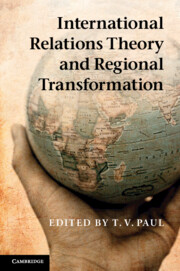Book contents
- Frontmatter
- Contents
- Figures and tables
- About the contributors
- Acknowledgments
- Part 1 Introduction
- Part 2 Realist perspectives
- Part 3 Liberal perspectives
- 5 Economic interdependence and regional peace
- 6 Regional organizations àla carte
- 7 Transforming regional security through liberal reforms
- Part 4 Constructivist perspectives
- Part 5 Eclectic perspectives
- Part 6 Conclusions
- Index
- References
6 - Regional organizations àla carte
the effects of institutional elasticity
Published online by Cambridge University Press: 05 June 2012
- Frontmatter
- Contents
- Figures and tables
- About the contributors
- Acknowledgments
- Part 1 Introduction
- Part 2 Realist perspectives
- Part 3 Liberal perspectives
- 5 Economic interdependence and regional peace
- 6 Regional organizations àla carte
- 7 Transforming regional security through liberal reforms
- Part 4 Constructivist perspectives
- Part 5 Eclectic perspectives
- Part 6 Conclusions
- Index
- References
Summary
Referring to the Kantian tripod, Russett and Oneal famously observed a virtuous circle whereby domestic democratic institutions, economic interdependence, and international organizations encourage peaceful relations among states. As the development of the North American Free Trade Association (NAFTA), Mercado Común del Sur (Mercosur) and the European Union suggests, two of these phenomena – trade and organization – tend to cluster at the regional level. In this volume John Owen looks at economic interdependence while John Oneal addresses both economic interdependence and liberal democracy. In our chapter we borrow the lens of institutionalism to focus on the role of formal international organizations in the creation and maintenance of peaceful regional orders.
Institutionalism has many facets that variably stress different types of agency and stages of institutionalization. We pay particular attention to three of them: neoliberal institutionalism, liberal intergovernmentalism, and neofunctionalism. While we discuss and build on institutionalism, we also propose a somewhat different way of looking at the impact of institutions on regional order. We argue that, although institutionalism has much to contribute to our understanding of the role of formal organizations, there has been a tendency in this literature to look at these organizations in isolation, thus neglecting the specific properties of an institutional architecture (i.e., how different regional organizations are assembled together) and the impact that these properties have on regional order. Analyzed in isolation, the impact of organizations may thus have been underestimated or not appropriately appreciated. A dense web of international institutions creates differentiated multilateral cooperation, which minimizes the risk of zero-sum politics. Not all states within a region are members of the same institutions and some may have opted out of some policy domains within an institution, but if they are all entangled in a web of institutions (even to varying degrees), this increases the opportunity cost of conflict. While we do not argue that international organizations provide a better explanation of stability and peace than economic interdependence or liberal democracy, our chapter compares the European case with other world regions to illustrate the value added of factoring in the institutional architecture of a region.
- Type
- Chapter
- Information
- International Relations Theory and Regional Transformation , pp. 133 - 157Publisher: Cambridge University PressPrint publication year: 2012
References
- 14
- Cited by



